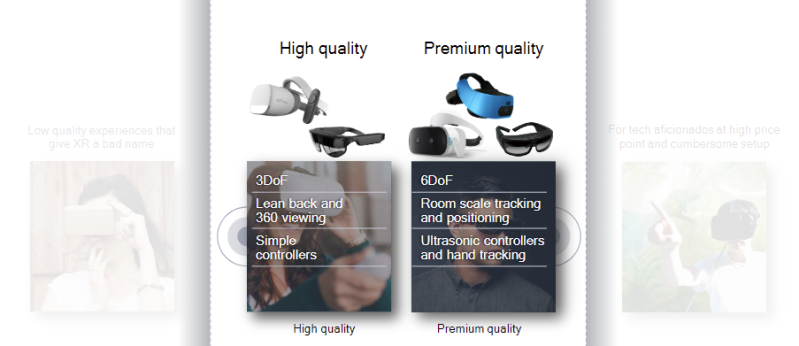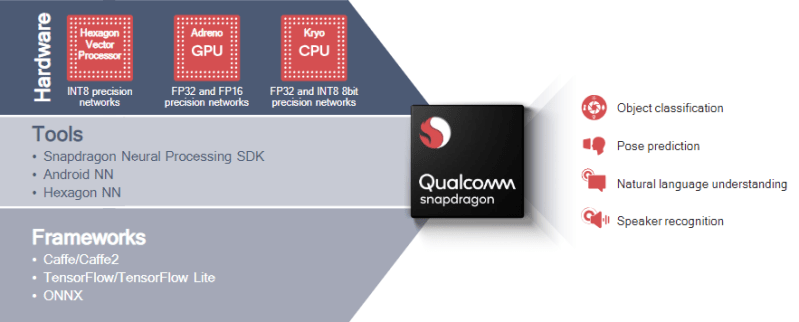The augmented reality (AR) and virtual reality (VR) markets have seen their ups and downs, but Qualcomm remains unabashedly convinced that they’re an untapped goldmine. Citing research from IDC, the company expects the install base for standalone headsets like the HTC Vive Focus and Oculus Go to top 186 million by 2023.
That is one of the reasons the San Diego-based chipmaker two years ago announced a standalone VR headset reference design based on its Snapdragon 820 system-on-chip, and in early 2018 unveiled an upgraded version packing the Snapdragon 845. At the Augmented Reality World 2018 Expo in Santa Clara today, Qualcomm took the wraps off the platform’s latest incarnation, the Snapdragon XR1 platform (short for “Extended Reality 1”) — but unlike previous reference designs, it isn’t just intended for VR.
“It’s … purpose-built for the standalone VR and AR [headset] category,” Hugo Swart, head of XR business management at Qualcomm, told VentureBeat during a pre-briefing ahead of the announcement. “It’s a demonstration of how much [we] believe in the VR and AR space. We have a good view on where the market is and where it’s going.”
As Hugo tells it, the impetus for the Snapdragon XR1 platform was twofold: the high price point of current-generation AR/VR headsets, and the inelegance of aftermarket accessories like Samsung Gear VR and Google Daydream View. About 45 percent of consumers think that today’s AR and VR devices are too pricey, according to research firm Techanalysis, and 46 percent prefer standalone devices compared to smartphone-dependent alternatives.
“Some of the headsets out there are expensive and not as easy to set up,” he said, “and not everyone has the latest and greatest smartphone.”

To address that market gap, the XR1 platform, in terms of its feature set, occupies a slightly lower tier than Qualcomm’s Snapdragon 845 Xtended Reality (XR) platform, complementing it rather than replacing it. Hiren Bhinde, XR product management director, compared it to the difference between a “high quality” experience (the XR1) and a “premium quality” experience (the Snapdragon 845 platform).
“From an engineering perspective, we went back and looked at the [Snapdragon 845 VR] platform and said, ‘Maybe the memory bandwidth could be less, and let’s tone down the capabilities of the GPU,'” Bhinde explained. “[XR1 devices] have the minimum criteria for immersion.”
XR1 devices, then, won’t be as capable as their high-end Snapdragon 845 counterparts. They’ll only have six degrees of freedom (3DoF) instead of the latter’s six (6DoF) — they’ll be able to track the roll, yaw, and pitch of a person’s head but not its position in 3D space — and they’ll ship with 6DoF controllers instead of ultrasonic and hand-tracking peripherals. XR1 headsets also won’t support room-scale tracking and positioning, or eye tracking.
“[XR1 headsets] are designed for ‘lean back,’ video-centric experiences like 360-degree 2D video, simple gaming, and simple interactivity at a lower price point,” Bhinde said. “Those are the experiences we’re targeting with XR1.”

Above: A comparison between the XR1 platform and Snapdragon 845-based headsets.
Driving those experiences is a new Snapdragon chip designed specifically for the XR1 platform. The chip, which supports Qualcomm’s existing Snapdragon XR Software Development Kit (SDK), comprises the company’s Hexagon Vector Processor (a chip optimized for machine learning workloads) and Kryo processors (based on architecture licensed from British semiconductor company and Softbank subsidiary Arm Holdings), as well as a graphics processing unit (GPU) from Qualcomm’s Adreno family. .
The hardware delivers the goods. Thanks to the Adreno GPU and Qualcomm’s Spectra ISP, the XR1 platform can output resolutions up to 4K (3,840 x 2,160) in resolution at 60 frames per second across one or two OLED or LCD displays, minimizing motion-to-photon latency — the amount of time it takes for a camera to capture light and hardware to process, render, and display it as AR content — to 20 milliseconds or less. It can perform visual inertial odometry (VIO), a technique that uses a combination of camera and motion sensor data to track headset movement in 3D space. (It is how apps developed on Apple’s ARKit track movement around a room.) And it supports standard graphics APIs like OpenGL, OpenCL, and Vulkan.
Manufacturers that choose to adopt the XR1 platform will have Qualcomm’s audio technologies at their disposal as well, including Qualcomm’s aptX audio compression algorithms and Aqstic, a collection of high-fidelity audio codecs, digital-to-analog converters (DACs), amplifiers, and software. Headlining features include immersive sound via a 3D Audio SDK, active noise cancellation, speech recognition, and natural language processing.
Finally, with the Hexagon Vector Processor in tow and the ability to split workloads among the Adreno GPU and Kryo CPU, the XR1 supports the full range of artificial intelligence frameworks and tools. That includes Qualcomm’s Snapdragon Neural Processing SDK, and also Facebook’s Caffe and Caffe2, Google’s TensorFlow and TensorFlow Lite, and the Open Neural Network Exchange (ONNX).

Google researchers recently demonstrated the value of AI in AR/VR applications with an algorithm that adds 6DOF controller-tracking capabilities to standalone headsets.
“[We’re] laying the foundation for machine learning algorithms [on XR1],” Bhinde said. “In VR [and] AR, it’s useful to predict where the wearer’s head is going to move [so] you’re able to save more power on the device.”
If all goes according to plan, it won’t be long before the first XR1 devices hit the market. Qualcomm’s initial list of partners includes Meta, an enterprise AR headset OEM, along with Pico, Vuzix, and HTC subsidiary Vive — with more to come in the months ahead. “We’re working a lot with everyone in the industry, from OEMs to platform guys, as well as technology partners [and] component suppliers,” Swart said.
“Our Vive Wave platform is setting the foundation for the next generation of all-in-one VR with access to a curated storefront of VR applications for mobile-centric VR,” Rikard Steiber, senior vice president of virtual reality at HTC, said in a statement. “With Qualcomm’s new XR1 chipset — we believe the AIO market and the Wave platform will both be poised to grow.”
